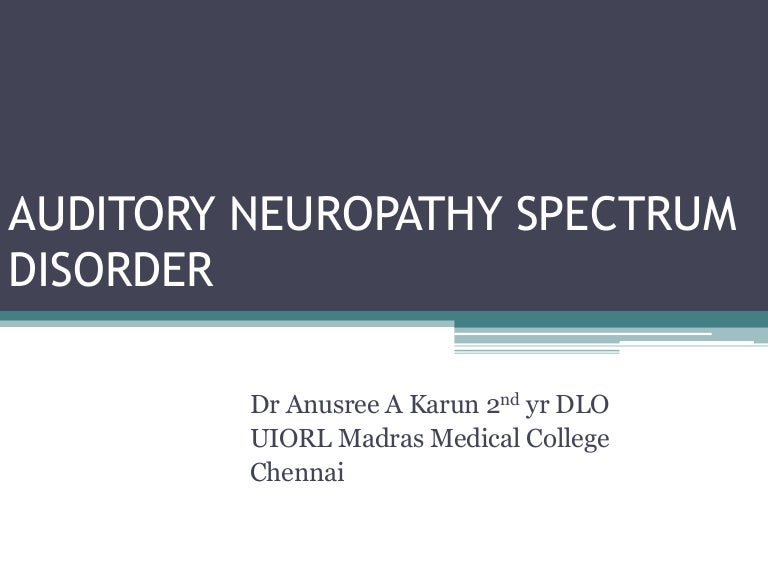
- #AUDITORY NEUROPATHY SPECTRUM DISORDER RECOMMENDAIONS TRIAL#
- #AUDITORY NEUROPATHY SPECTRUM DISORDER RECOMMENDAIONS SERIES#
#AUDITORY NEUROPATHY SPECTRUM DISORDER RECOMMENDAIONS TRIAL#
In addition, the genetic cause of ANSD will indicate the need for early trial of amplification and cochlear implantsĭue to the high incidence of ANSD and other hearing deficits in infants in the NICU, it is recommended that these infants are primarily screened with AABR. Genetic screening can also provide etiological information for different medical prognosis and syndromes, such as Friedreich’s Ataxia and Charcot-Marie-Tooth Syndrome. However, genetic and cytomegalovirus testing can help discover many late-onset progressive hearing loss cases as well as the otoferlin, pejvakin and other mutations in healthy babies. Genetic screening of infants with ANSD can provide ethical issues and informed consent should be taken from parents prior to testing. OTOF gene and otoferlin (most common) 7.In addition, several genetic mutations have been reported 9 in children with ANSD and include:

Some studies have found that ANSD can be caused by cochlear nerve deficiency (Buchman et al 2006 8) as well as tumors or cysts (Boudewyns et all 2018). It is possible to explore etiological factors of ANSD in well-baby populations. This leaves 50% of ANSD children who have NOT spent time in the NICU – and may be missed if they do not receive AABR screening at birth.ĪNSD can be inherited or acquired 7. The incidence is higher in the NICU graduate population being up to 10-15% with the NHS Newborn Hearing Screening Program (NHSP) Evaluation from 2004 6 showing that 0.2% of babies in neonatal intensive care units suffer from ANSD (Heather 2014) and demonstrating that about 50% of ANSD children have spent time in the NICU 7. The prevalence of ANSD in the well-baby population with confirmed congenital hearing loss varies between 6.5% (Boudewyns et al 4) and up to 10% 5. But the current prevalence estimates in children show that one to three children per 10,000 births are affected by ANSD. This shows poor responses from the auditory nerve, the inner hair cells or the basal ganglia.ĪNSD can affect people of all ages, from birth to adulthood. In ANSD patients, ABR will be absent or severely abnormal when maximal stimulus is used.
#AUDITORY NEUROPATHY SPECTRUM DISORDER RECOMMENDAIONS SERIES#
Each click evokes a series of identifiable brain waves from the infant’s auditory brainstem which are measured by electrode sensors placed on the child’s forehead, nape of neck and shoulder. Ear couplers are placed over the infant’s ear, and a sound stimulus of 35dBnHL or 40dBnHL is delivered into the ear canal.

This screening method can determine if the brain is receiving information in a clear way. But as ANSD is characterized by a normal cochlear function, OAEs and/or cochlear microphonic (CM) will be present at some point and the screening of the outer hair cells with OAE will pass as normal.Īutomated auditory brainstem response (AABR) examines how well the auditory nerve sends sound from the inner ear to the brainstem by screening the entire hearing pathway. In most cases of childhood hearing loss, the outer hair cells are damaged or absent. While the child is quiet and settled or asleep, a small probe is placed in the ear canal to deliver a click or tone sound and a microphone within the probe measures the acoustic response from the cochlea to that sound stimulus. Otoacoustic emissions (OAEs) measure the function of outer hair cells in the cochlea, which are responsible for sound stimulus amplification. How OAE and AABR screening can help ANSD diagnosis? As such, the audiogram is a limited tool for diagnosing this auditory dysfunction that can have a considerable impact on a child’s speech and language development. ANSD may result from both syndromic and non-syndromic genetic anomalies, environmental causes, as well as structural anomalies 1.Īccording to Sininger & Oba’s study from 2001 2, speech perception in ANSD patients is considerably worse than can be predicted from a pure-tone audiogram.

The level of hearing loss can vary from mild to profound, but there is often a mismatch between the hearing threshold and speech perception abilities.

ANSD is an auditory dysfunction where the ear receives sounds, but damage at some point along the auditory nerve results in the child not being able to process sound normally. What is Auditory Neuropathy Spectrum Disorder?Īuditory neuropathy spectrum disorder (ANSD) can present at any age and affects approximately one to three children per 10,000 births.


 0 kommentar(er)
0 kommentar(er)
